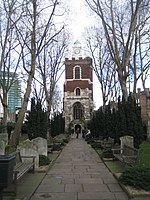Bow Interchange
Bow, LondonBromley-by-BowRoad junctions in LondonStratford, LondonTransport in the London Borough of Newham ... and 2 more
Transport in the London Borough of Tower HamletsUse British English from November 2016

Bow Interchange is a busy grade-separated road junction in London, England, on the East Cross Route (part of the A12 road) between Bow, Stratford, and Bromley-by-Bow at a point where the London Boroughs of Tower Hamlets and Newham meet. It is a triple-level junction where the East Cross Route (the A12), Bow Road (the A11 road), and Stratford High Street (the A118 road) meet. The River Lea runs underneath the junction. The East Cross Route is a major road in East London which runs north to the North Circular Road and south to the Blackwall Tunnel.
Excerpt from the Wikipedia article Bow Interchange (License: CC BY-SA 3.0, Authors, Images).Bow Interchange
Bow Roundabout, London Bow
Geographical coordinates (GPS) Address Nearby Places Show on map
Geographical coordinates (GPS)
| Latitude | Longitude |
|---|---|
| N 51.52969 ° | E -0.01412 ° |
Address
Bow Roundabout
Bow Roundabout
London, Bow
England, United Kingdom
Open on Google Maps








